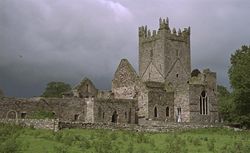Jerpoint Abbey
Mainistir Sheireapúin | |
 East front of Jerpoint Abbey | |
| Monastery information | |
|---|---|
| Order | Cistercians |
| Established | 1180 |
| Disestablished | 1541 |
| Diocese | Ossory |
| People | |
| Founder(s) | Donchadh Ó Donnchadha Mac Giolla Phátraic, King of Osraige |
| Architecture | |
| Status | Inactive |
| Style | Cistercian |
| Site | |
| Location | Thomastown, County Kilkenny, Ireland |
| Coordinates | 52°30′39″N 7°09′29″W / 52.51093°N 07.15798°W |
| Public access | No |
| Official name | Jerpoint Abbey |
| Reference no. | 80 |
Jerpoint Abbey is a ruined Cistercian abbey, founded in the second half of the 12th century, near Thomastown, County Kilkenny, Ireland. It is located 2.5 km south west from Thomastown on the R448 regional road. There is a Visitor Centre with an exhibition. It has been declared a national monument and has been in the care of the Office of Public Works since 1880.
It was constructed in 1180, by Donchadh Ó Donnchadha Mac Giolla Phátraic, the King of Osraige. It was dedicated to the Blessed Virgin. Jerpoint is notable for its stone carvings, including one at the tomb of Felix O'Dulany, Bishop of the Diocese of Ossory. The abbey flourished until the Dissolution of the Monasteries by the English king Henry VIII.
Jerpoint Abbey gives its name to the civil parish of Jerpoint Abbey or Abbey-Jerpoint in the barony of Knocktopher. It lies near the anciently corporate town of Newtown Jerpoint.
History

In 1180, by Donogh O'Donoghoe Mac Gilla Patraic, the King of Kingdom of Ossory, moved the monks of the Cistercian Order from a distant part of Ossory to the present site. Here he constructed the abbey, probably on the site of an earlier Benedictine monastery built in 1160 by Domnall Mac Gilla Patraic, King of Osraige.[1]
The abbey continued to flourish until the Dissolution of the Monasteries by Henry VIII. It was surrendered to the king by Oliver Grace, the last abbot. In 1541 it was granted by Philip and Mary to James Butler, the 9th Earl Earl of Ormond. The abbey became a favourite place of sepulture with all the great families in the surrounding country. In 1202, Felix O'Dullany, Bishop of Ossory, was interred here.
It has been declared a national monument and has been in the care of the Office of Public Works since 1880.
Architecture



The present ruins are very extensive and display some specimens of the later Norman passing into the early English style of architecture. Jerpoint is notable for its stone carvings, including one at the tomb of Felix O'Dulany, Bishop of the Diocese of Ossory.
There is a well-proportioned, square, embattled tower. The church with its Romanesque details dates from the 12th century. In the transept chapels are 13th to 16th century tomb sculptures. The tower and cloister date from the 15th century. In the Abbey is the sculptured cloister arcade with unique carvings.
Legends
Close to Jerpoint Abbey, at Newtown Jerpoint, are the ruins of a church where a local legend places the grave of Saint Nicholas.[2]
People
- William of Jerpoint, was elected Bishop of Cork in March 1265 until November 1266.
See also
Notes
- ^ Mac Annaidh 2001.
- ^ Myth of Santa's Grave Archived 8 December 2006 at the Wayback Machine
References
- Anderson, Paris (1848), Nooks and Corners of County Kilkenny. (PDF), Kilkenny: Kilkenny People Printing Works, James's Street.
- Mac Annaidh, S (2001), Illustrated Dictionary of Irish History., Dublin: Gill and Macmillan.
- O'Conbhuidhe, Colmcille (1963), "The origins of Jerpoint abbey, Co. Kilkenny", Cîteaux; Commentarii Cistercienses, pp. 293–306.
- Ford, Linda; William Doran (1980). "Wall paintings at Jerpoint Abbey, Co. Kilkenny—a note". Old Kilkenny Review. 2 (2): 71–72..
- Hegarty, Maureen (1971). "Jerpoint". Old Kilkenny Review (23): 4–14..
- Heritage Council. Conservation Plan: Newtown Jerpoint County Kilkenny (PDF). The Heritage Council. Archived from the original (PDF) on 12 October 2016. Retrieved 20 January 2010..
- Harbison, Peter (1973). "An illustration of the lost Walsh knight from the Jerpoint Cloister arcade". Old Kilkenny Review (25): 13–15..
- Kilroy, Deirdre (1990). "Essays from Project 1989 Irish National Heritage: The ancient church at Newtown Jerpoint". Old Kilkenny Review. 4 (2): 782–784..
- KAS (2004). "Jerpoint Abbey: an historical perspective". Old Kilkenny Review: 125–138..
- Langrishe, R. (1906). "Notes on Jerpoint Abbey, County Kilkenny". The Journal of the Royal Society of Antiquaries of Ireland. 36 (36): 179–97. JSTOR 25507522..
- Leask, H. (1939), Jerpoint Abbey, Co. Kilkenny (Guidebook)..
- Leroux-Dhuys, J. (1998), Cistercian Abbeys: History and Architecture..
- Pochin Mould, Daphne (1976), The Monasteries of Ireland..
- Manning, Conleth (1975). "Jerpoint cloister fragment at Sheepstown". Old Kilkenny Review. 1 (2): 118–119..
- Murtagh, Ben (1997). "The medieval parish church and graveyard of St. Nicholas, Newtown Jerpoint". Old Kilkenny Review (49): 118–129..
- Pilsworth, W.J. (1958). "Newtown Jerpoint". Old Kilkenny Review. Number 10: 31–35.
{{cite journal}}:|volume=has extra text (help). - Rae, E.C. (1966). "The sculpture of the cloister of Jerpoint abbey". The Journal of the Royal Society of Antiquaries of Ireland. 96 (96): 59–91. JSTOR 25509606..
- Ryan, Michael Fitz G. (1972). "Tumulus in Jerpoint West, preliminary note". Old Kilkenny Review (24): 60–61..
- Stalley, R. (1987), The Cistercian monasteries of Ireland: an account of the history, art and architecture of the White Monks in Ireland from 1142 to 1540..
- Scanlon, J.D. (1966). "Jerpoint library duplicates". Old Kilkenny Review (15): 36..
- 1180 establishments in Ireland
- Tourist attractions in County Kilkenny
- Buildings and structures in County Kilkenny
- Cistercian monasteries in the Republic of Ireland
- Religion in County Kilkenny
- Religious organizations established in the 1180s
- Ruins in the Republic of Ireland
- Christian monasteries established in the 12th century
- National Monuments in County Kilkenny
- FitzPatrick dynasty
- Civil parishes of County Kilkenny
- Knocktopher

